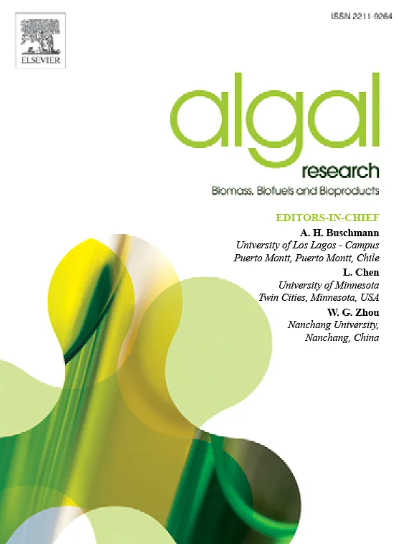食品级藻类去除甲基紫和亚甲基蓝有毒染料的温和磺化工艺:统计建模和可取性函数优化
IF 4.6
2区 生物学
Q1 BIOTECHNOLOGY & APPLIED MICROBIOLOGY
Algal Research-Biomass Biofuels and Bioproducts
Pub Date : 2025-04-14
DOI:10.1016/j.algal.2025.104040
引用次数: 0
摘要
在本研究中,食品级藻类(FGA)在100°C下,在1 M硫酸(H2SO4)中通过水热辅助活化4 h,进行了轻度磺化过程。磺化FGA (S-FGA)作为一种潜在的生物吸附剂,用于去除水中两种结构类型的阳离子染料,即甲基紫(MV)和亚甲基蓝(MB)。因此,采用XRD、FTIR、SEM-EDX、pHpzc等多种分析方法对S-FGA生物吸附剂的理化性质进行了研究。此外,采用Box-Benken设计(BBD)对S-FGA对MV和MB染料的吸附性能进行了统计优化。在此过程中,优化了S-FGA生物吸附剂用量(A: 0.02 ~ 0.1 g/100 mL)、染料溶液pH (B: 4 ~ 10)、接触时间(C: 10 ~ 120 min)等关键吸附参数。因此,理想函数结果表明,当S-FGA用量为0.09 g/100 mL, pH为8.2,接触时间为119 min时,MV的去除率为94.9%,而当S-FGA用量为0.09 g/100 mL, pH为9.5,接触时间为109 min时,MB的去除率为74%。MV和MB染料在S-FGA表面的吸附动力学和等温线分别符合准二阶动力学和Freundlich等温线模型。S-FGA对MV和MB染料的生物吸附量(Langmuir模型)分别为224.6 mg/g和406.1 mg/g。热力学分析表明,这是一个自发的放热驱动的生物吸附过程,在固液界面上随机性降低(ΔS°<;0). S-FGA对MV和MB染料的生物吸附可能受氢键、吉田- h键和静电吸引的影响。因此,食用藻类生物质基磺化生物吸附剂在有效去除污染水中这些有毒阳离子染料方面具有广阔的应用前景。本文章由计算机程序翻译,如有差异,请以英文原文为准。
Mild sulfonation process of food grade algae for removal of methyl violet and methylene blue toxic dyes: Statistical modelling and desirability function optimization
In this study, food-grade algae (FGA) underwent a mild sulfonation process via hydrothermal process-assisted activation in 1 M sulfuric acid (H2SO4) for 4 h at 100 °C. The sulfonated FGA (S-FGA) was applied to be a potential biosorbent for removal of two structural types of cationic dyes, namely, methyl violet (MV) and methylene blue (MB) from aqueous media. Thus, the physicochemical properties of S-FGA biosorbent were investigated using several analytical methods including XRD, FTIR, SEM-EDX, and pHpzc. Moreover, the adsorptive performance of S-FGA towards MV and MB dyes was statistically optimized using the Box-Benken design (BBD) with desirability functions. In this process, the key biosorption parameters including S-FGA biosorbent dose (A: 0.02–0.1 g/100 mL), pH of the dye's solution (B: 4–10), and the contact time (C: 10–120 min) were optimized. Thus, the desirability function results indicate the best removal of MV (94.9 %) was achieved using 0.09 g/100 mL of S-FGA dose, pH of 8.2, and contact time of 119 min, while MB removal (74 %) was reached using 0.09 g/100 mL of the S-FGA, pH of 9.5, and 109 min of contact time. The kinetic and isotherm profiles of the biosorption process for MV and MB dyes onto the S-FGA surface followed the pseudo-second order (PSO) kinetic and Freundlich isotherm models, respectively. The estimated biosorption dye capacity (Langmuir model) for MV and MB dyes by S-FGA was 224.6 mg/g and 406.1 mg/g, respectively. The thermodynamic analysis indicates a spontaneous and exothermic-driven biosorption process with decreased randomness at the solid-liquid interface (ΔS° < 0). The biosorption of MV and MB dyes by S-FGA was likely governed by contributions due to hydrogen bonding, Yoshida-H bonding, and electrostatic attractions. Hence, the sulfonation of food algae biomass-based biosorbent shows promising potential for the effective removal of these toxic cationic dyes from contaminated water.
求助全文
通过发布文献求助,成功后即可免费获取论文全文。
去求助
来源期刊

Algal Research-Biomass Biofuels and Bioproducts
BIOTECHNOLOGY & APPLIED MICROBIOLOGY-
CiteScore
9.40
自引率
7.80%
发文量
332
期刊介绍:
Algal Research is an international phycology journal covering all areas of emerging technologies in algae biology, biomass production, cultivation, harvesting, extraction, bioproducts, biorefinery, engineering, and econometrics. Algae is defined to include cyanobacteria, microalgae, and protists and symbionts of interest in biotechnology. The journal publishes original research and reviews for the following scope: algal biology, including but not exclusive to: phylogeny, biodiversity, molecular traits, metabolic regulation, and genetic engineering, algal cultivation, e.g. phototrophic systems, heterotrophic systems, and mixotrophic systems, algal harvesting and extraction systems, biotechnology to convert algal biomass and components into biofuels and bioproducts, e.g., nutraceuticals, pharmaceuticals, animal feed, plastics, etc. algal products and their economic assessment
 求助内容:
求助内容: 应助结果提醒方式:
应助结果提醒方式:


